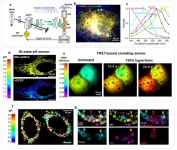Anesthetic may affect tau spread in the brain to promote Alzheimer's disease pathology
Research also provides new insights on mechanisms behind tau spread and how it promotes cognitive impairment
2021-05-12
(Press-News.org) BOSTON - During the development and progression of Alzheimer's disease, a protein called tau accumulates and spreads in the brain. Understanding the mechanisms behind tau spread--and its consequences--may point to new prevention and treatment strategies for Alzheimer's disease and other forms of dementia. New insights now come from research that was led by investigators at Massachusetts General Hospital (MGH) and involves an anesthetic known to affect cognitive function. The findings are published in Communications Biology.
The scientists note that inflammation plays an important role in Alzheimer's disease, and microglia--immune cells that reside in the brain--are thought to be involved in this process by producing an inflammatory molecule called interleukin-6. To see if tau stimulates microglia to drive the development of Alzheimer's disease pathology, the MGH investigators and their colleagues conducted experiments with an inhaled anesthetic called sevoflurane. Their previous work showed that sevoflurane can cause a change (specifically, phosphorylation, or the addition of phosphate) to tau that leads to cognitive impairment in mice. Other researchers have also found that sevoflurane and certain other anesthetics may affect cognitive function.
In this current study, the team developed a novel method to measure tau levels, called nanobeam-sensor technology. "The nanobeam sensor is ultrasensitive, requires a small volume, and can measure low concentrations of molecules, including tau and phosphorylated tau," says co-lead author Feng Liang, MD, PhD, an instructor in the Department of Anesthesia, Critical Care and Pain Medicine (DACCPM) at MGH.
The group conducted experiments in mice and cells and discovered that sevoflurane causes tau to leave neurons and enter microglia, where it stimulates the cells' production of interleukin-6, which in turn leads to inflammation and cognitive impairment. The trafficking of tau from neurons to microglia involves tau phosphorylation and membrane-bound carriers called extracellular vesicles that are released from cells.
"These data demonstrate anesthesia-associated tau spreading and its consequences," says senior author Zhongcong Xie, MD, PhD, director of the Geriatric Anesthesia Research Unit in the DACCPM. "This tau spreading could be prevented by inhibitors of tau phosphorylation or extracellular vesicle generation."
Sevoflurane did not increase the release of lactate dehydrogenase, a molecule with a similar size and weight as tau, from neurons. "This finding indicates that neuronal cell membranes and cell viability were not compromised by sevoflurane treatment and that the sevoflurane-induced leaking of tau was not a passive process," says co-lead author Yuanlin Dong, MD, a research fellow in the department.
Another inhaled anesthetic called desflurane did not have the same effects as sevoflurane. "Our results suggest that the anesthetics sevoflurane and desflurane may have different impacts on tau phosphorylation and tau spreading. More important, sevoflurane may be used as a clinically relevant tool to study tau spreading and its underlying mechanisms," says Xie. "We hope this work will lead to more research on anesthesia, tau proteins, and Alzheimer's disease pathology that will ultimately improve care for patients."
INFORMATION:
Additional co-authors are Lining Huang, MD, PhD, MGH DACCPM and Hebei Medical University, China; Fang Fang, MD, PhD, MGH DACCPM and Fudan University, China; Guang Yang, PhD, Columbia University Medical Center; Rudolph E. Tanzi, PhD, MassGeneral Institute for Neurodegenerative Disease; Yiying Zhang, MD, PhD, MGH DACCPM; and Qimin Quan, PhD, Rowland Institute of Harvard University and NanoMosaic.
The study was supported by the National Institutes of Health, including both the National Institutes of Aging and the Eunice Kennedy Shriver National Institute of Child Health & Human Development.
About the Massachusetts General Hospital
Massachusetts General Hospital, founded in 1811, is the original and largest teaching hospital of Harvard Medical School. The Mass General Research Institute conducts the largest hospital-based research program in the nation, with annual research operations of more than $1 billion and comprises more than 9,500 researchers working across more than 30 institutes, centers and departments. In August 2020, Mass General was named #6 in the U.S. News & World Report list of "America's Best Hospitals."
ELSE PRESS RELEASES FROM THIS DATE:
2021-05-12
Since the discovery of Alzheimer's disease over a century ago, two hallmarks of the devastating illness have taken center stage.
The first, known as amyloid plaques, are dense accumulations of misfolded amyloid protein, occurring in the spaces between nerve cells. Most efforts to halt the advance of Alzheimer's disease have targeted amyloid protein plaques. To date, all have met dispiriting failure.
The second classic trait has, until recently, received less scrutiny. It consists of string-like formations within the bodies of neurons, produced by another crucial protein-- tau. These are known as neurofibrillary tangles.
In a new study, researchers with the ASU-Banner Neurodegenerative Disease Center at the Biodesign ...
2021-05-12
PHILADELPHIA--A low-cost, rapid diagnostic test for COVID-19 developed by Penn Medicine provides COVID-19 results within four minutes with 90 percent accuracy. A paper published this week in Matter details the fast and inexpensive diagnostic test, called RAPID 1.0 (Real-time Accurate Portable Impedimetric Detection prototype 1.0). Compared to existing methods for COVID-19 detection, RAPID is inexpensive and highly scalable, allowing the production of millions of units per week.
Despite the urgency of the pandemic, most available methods for COVID-19 testing use RT-PCR--reverse transcription polymerase chain reaction--to detect ...
2021-05-12
Central to any technological progress is the enrichment of human life. The internet and wireless connectivity have done that by allowing not only virtually anyone anywhere to connect real time, but by making possible connections between humans and a range of intelligent devices both indoors and outdoors, putting smart cities on the horizon.
One key aspect of realizing smart cities is "smart vehicles", the latest development in intelligent transportation systems (ITS), which involve the integration of communication, mapping, positioning, network, and sensor technologies to ensure cooperative, efficient, intelligent, safe, and economical transportation.
For decades, research on bringing to the streets smart vehicles that operate ...
2021-05-12
The field of magnonics offers a new type of low-power information processing, in which magnons, the quanta of spin waves, carry and process data instead of electrons. The end goal of this field is to create magnonic circuits, which would be smaller and more energy-efficient than current electronic ones.
Until recently, the development of a functional magnonic device could take years of trial-and-error. Researchers from the University of Vienna and the TU Kaiserslautern have developed a new computational method to design new devices in a considerably shorter time. Moreover, the efficiency added through this novel inverse design method helps overcome a traditional problem with such devices: they were just suitable for one function only. Now, thanks to the proposed ...
2021-05-12
The inhibition of pathological protein-protein interactions is a promising approach for treating a large number of diseases, including many forms of cancer. A team of researchers has now developed a bicyclic peptide that binds to beta-catenin--a protein associated with certain types of tumor. The secret of their success is the cyclic nature and the hairpin shape of the peptide, which mimics a natural protein structure, they report in the journal Angewandte Chemie.
Because of the extensive protein regions involved in protein-protein interactions, therapeutic approaches involving small molecules are often unsuccessful. Protein mimetics are alternatives that imitate the spatial structure of binding segments of natural protein binding partners. ...
2021-05-12
In a new study from Lund University and the University of Gothenburg, patients were interviewed about their experiences ten years after undergoing obesity surgery. The results show that the effect on eating and weight regulation persisted, whereas other problems, such as feelings of guilt about still not being healthy enough, remained.
"This is one of few follow-ups from a patients perspective so long after surgery", says My Engström, researcher in nursing at the University of Gothenburg.
18 patients were interviewed in the study. All of them experienced that their eating habits and appetite were still affected after the operation: their bodies still objected, preventing ...
2021-05-12
Mycobacterium tuberculosis is incredible in that it can survive for decades within its human host. It does this by varying its diet to successfully steal nutrients from the human host including immune cells; it is known to acquire and absorb multiple carbon sources from the body during infection.
In a paper published in the journal Molecular Systems Biology, Surrey scientists detail how they measure the flow of metabolites or "fluxes" through metabolic pathways when Mycobacterium tuberculosis is consuming some of its favourite nutrients. Measuring these 'fluxes' could help scientists advance new tuberculosis drugs as well as understand why the bacterium survives so long in humans and why current antibiotics are often ineffective.
By growing Mycobacterium ...
2021-05-12
The multiplexing capability of fluorescence microscopy is severely limited by the broad fluorescence spectral width. Spectral imaging offers potential solutions, yet typical approaches to disperse the local emission spectra notably impede the attainable throughput and place substantial constraints on temporal resolution. Tunable bandpass filters provide a possibility to scan through the emission wavelength in the wide field. However, applying narrow bandpasses to the fluorescence emission results in inefficient use of the scarce signal.
In a new paper published in Light: Science & Application, a team of scientists, led by Professor Ke Xu ...
2021-05-12
The DNA sequences produced are also called oligonucleotides. These are widely used for disease identification, for the manufacture of oligonucleotide-based drugs, and for several other medical and biotechnological applications.
The high demand for oligonucleotides therefore requires an efficient automated method for their chemical production.This process relies on phosphoramidites, which are chemical compounds that have the disadvantage of being unstable unless stored at the ideal -20 degrees Celsius.
Instruments used for DNA synthesis are not able to cool down the phosphoramidites, and consequently it is unavoidable that some of them degrade after being added ...
2021-05-12
"We're meant to be crossing over ... but the bridge is broken": 2020 university graduates' experiences of the pandemic in Ireland
A new study from Trinity College Dublin investigating the impact of the COVID pandemic on young adults finds that they are vastly more affected than older people, and the reverberations of the disruption to some will last decades. Researchers say this group have paid a high price in the form of foregone opportunities for education, social networks, and labour market integration.
The research, involving university graduates in Ireland, is published in YOUNG: ...
LAST 30 PRESS RELEASES:
[Press-News.org] Anesthetic may affect tau spread in the brain to promote Alzheimer's disease pathology
Research also provides new insights on mechanisms behind tau spread and how it promotes cognitive impairment





